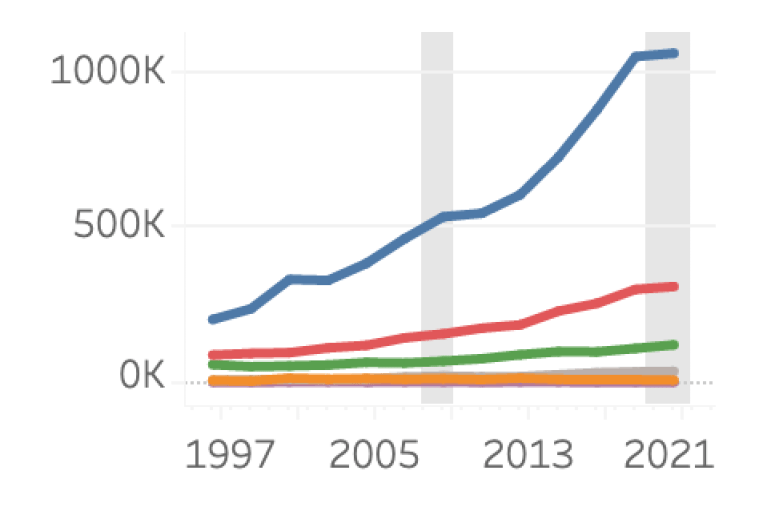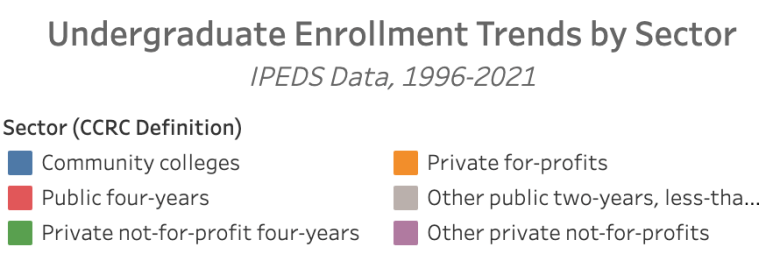When you think of a college student, you might imagine a young adult leaving home, moving into a dorm, navigating a campus and maybe attending a fraternity party. That’s an outdated image. We’ve written a lot about how older adults with jobs and children are a giant group on campus. But a more surprising species is spreading through the college registrar’s rolls: teenagers living at home, taking yellow buses to high school and maybe scrambling home before curfew.

The number of high schoolers taking college classes has been surging for more than two decades. In what is called dual enrollment, students simultaneously earn high school and college credits from a single class. These advanced college-level courses are no longer just for gifted students who have exhausted the high school course catalog. Now they’re a tool to encourage more Americans to enroll in college by giving them an early taste of post-secondary education and a head start with a few credits.
Dual enrollment students were estimated to number more than 1.4 million in the fall of 2022, and account for almost one out of five community college students. That’s according to estimates from the National Student Clearinghouse Research Center. Some scholars believe the total number could be much higher, perhaps 2 million students, when spring 2023 course taking is included. Dual enrollees appear to far outnumber the 1.1 million high school graduates in the class of 2022 who took at least one Advanced Placement exam.
“It’s meteoric,” said Brian An, a sociologist at the University of Iowa. “When I first started working in dual enrollment research in the mid 2000s, it was nowhere near these numbers. If you had told me 10 years ago that 20 percent of all community college students would be dual enrollment, I would have said that’s crazy talk.”
Community colleges oversee roughly 70 percent of dual enrollments with four-year colleges running the remaining 30 percent. Students often don’t pay any college tuition for dual enrollment classes. In most cases, high schoolers never step foot on a college campus; the class is taught in a high school classroom by a high school teacher. English composition and college algebra are popular.
The number of students 17 years old and under enrolled in a community college course increased sharply in the past 10 years.


Students are flocking to these courses because they perceive that it’s easier to earn college credits through dual enrollment than through Advanced Placement, said University of Iowa’s An. With Advanced Placement, students have to score high enough on an exam to earn college credit. With dual enrollment, a passing grade is sufficient.
The sharp growth in dual enrollment has raised a lot of questions about course content and whether students are really producing college-level work. John Fink, an expert in dual enrollment at the Community College Research Center, acknowledged that quality is uneven. That’s not surprising when 80 percent of high schools are now offering these courses and there’s decentralized oversight among thousands of colleges around the country. But colleges that oversee these courses are trying to improve quality, Fink said. (The Community College Research Center is a unit of Teachers College, Columbia University. The Hechinger Report is also an independent news organization based at Teachers College, but the two entities are not affiliated.)
Despite concerns about course rigor, research points to better outcomes for students. Between similar students with comparable grades and family backgrounds, the student who takes a dual enrollment class is more likely to graduate high school, enroll in college and earn a college degree, many studies have found. In 2017, the What Works Clearinghouse, a unit of the Department of Education that reviews education research, gave dual enrollment its stamp of approval with a strong level of evidence for it.
In qualitative research interviews, students described how dual enrollment courses taught them how to take notes or study for a test, helping them feel more prepared for college. Much of the benefit may be in boosting a student’s confidence and soft skills, and not necessarily in teaching academic content, University of Iowa’s An explained.
A big downside to dual enrollment is that students of color are underrepresented. That’s an ironic outcome given that advocates, including the Bill & Melinda Gates Foundation, pushed the expansion of these programs to help promote college going and attainment among Black and Hispanic students. Only one fifth of high schools have managed to enroll Black and Hispanic students in dual enrollment classes at the same or higher rates as white students, Fink said. (The Gates Foundation is among the many funders of The Hechinger Report.)
Another reason for the rapid expansion of dual enrollment may be financial. Dual enrollment courses are money losers for many community colleges, according to Fink at the Community College Research Center. That’s because colleges receive a discounted per-pupil allotment for each high schooler who signs up. Each state funds dual enrollment differently, often through a combination of state and school district budgets. Sometimes families need to contribute too, but it tends to be a lot cheaper than a usual college course.
But colleges can turn dual enrollment programs into a modest money maker when they serve more students, according to a February 2023 analysis by the Community College Research Center. Once fixed costs are covered, each additional student means an increase in revenues. For example, adding an additional high school teacher to an existing instructor training program isn’t very costly and could open up dozens more student slots, each generating income that flows to the college.
The reason that dual enrollments have become such a big slice of community colleges’ offerings is not only because more high school students are taking these courses, but also because fewer traditional students want to attend community colleges. When the pandemic hit in 2020, there were shocking double digit drops in enrollment at community colleges. Dual enrollment classes at many high schools temporarily shut down too, but they dramatically rebounded in 2022-23. Meanwhile, traditional students haven’t been returning to community colleges in large numbers, thanks to a strong job market. High school students even make up the majority of students at 31 community colleges, my colleague Jon Marcus found.
Precise numbers on exactly how many high schoolers are taking dual enrollment classes are hard to come by. The best data is from the National Student Clearinghouse, which receives enrollment data from most colleges in the country. But colleges report only the ages of their students and not whether they have finished high school. The estimates for dual enrollees are based on students 17 years and under and cross-checked against high school records available to the National Student Clearinghouse. We should get a clearer picture next year when the Department of Education is expected to release a more accurate report on the numbers, broken down by race and ethnicity.
This story about dual enrollment classes was written by Jill Barshay and produced by The Hechinger Report, a nonprofit, independent news organization focused on inequality and innovation in education. Sign up for Proof Points and other Hechinger newsletters.



The article omits an important point: quality control of the teacher. To qualify to teach dual enrollment in physics, for example, a teacher must earn 18 graduate credits in physics or physics education (a requirement by the Higher Learning Commission). On the other hand, any teacher is allowed to teach AP-physics. Aligned with this, the community college that oversees a dual enrollment program in physics in their region visits the classroom or monitors the implementation in some other way. I see this due to my professional development work with high school physics teachers in Maricopa County, AZ.
A few points to note…quality CAN be uneven but there are national program quality standards for the high school-based model (the most complex model that requires the most direct high school/college collaboration on all things including enrollment, instruction, and support service). These standards are configured and updated by program practitioners and researchers working with the only national dual/concurrent enrollment program accrediting body, NACEP. These standards help fill the gap between state higher ed and secondary policy as well as accreditors policy. Eleven states either require or incentivize NACEP accreditation for dual enrollment programs operating in their state (AR, IN, IA, KY, MN, MO, OR, RI, SD, SC, WA). Five states have state guidance or statute based on NACEP quality standards (CO, ID, MT, NH, VA), and an additional ten states (FL, IL, KS, ME, MI, NE, ND, OH, OK, UT) have incorporated components of the quality standards into state policy and or guidance.
The Gates Foundation’s early investments were more targeted at Early College High School models. These are whole-school models and typically target serving students from underrepresented communities. ECHs make up a very small part of the DE students nationally (there are only a few hundred that meet the federal definition). But there is a paradigm shift underway in the field at large and the more that colleges and high schools recognize the diverse groups of students that can benefit from these programs, the more we will see success in work to intentionally connect with and support students to close gaps in access and participation.